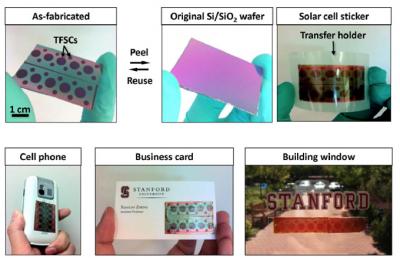The proposal, which will involve researchers from the Universities of Manchester, Cambridge and Lancaster, has been awarded 13.4 million Euros (around £11m) to form a "Synergy Group" by the European Research Council (ERC).
 This shows demonstrations of the Stanford peel-and-stick thin-film solar process and various applications. Credit: Chi Hwan Lee, Stanford School of Engineering.
This shows demonstrations of the Stanford peel-and-stick thin-film solar process and various applications. Credit: Chi Hwan Lee, Stanford School of Engineering.
It will aim to utilise two-dimensional substances, such as wonder material graphene, to engineer new types of materials which are just a few atoms thick, but nevertheless have the power to revolutionise the future development of devices such as solar cells, and flexible and transparent electronics.
Starting with one atom-thick substances which possess remarkable properties, the group will focus on ways in which they can be layered up to form 'heterostructures'. These heterostructures will still be just a few atoms thick, but will combine the properties of the different two-dimensional materials which comprise them, effectively enabling developers to embed the functions of a device into its very fabric.
For example, the research team envisage combining an atomic layer which functions as a sensor, with layers that function variously as an amplifier, transistor, or solar cell, for power generation. The resulting material, still just a few atomic layers in thickness, would be capable of running a whole circuit.
The award to launch the project was announced by the ERC as part of its first competition for 'Synergy Grants', which were introduced last year on a pilot basis. It will bring together the talents of the Nobel Prize-winner, Professor Kostya Novoselov at Manchester, Professor Andrea Ferrari at Cambridge, and Professor Vladimir Falko at Lancaster.
The team will be part of the UK's Graphene Global Research and Technology Hub, including the £61m National Graphene Institute, which is being developed at The University of Manchester to continue its world-leading and collaborative work in the field.
Widely regarded as a wonder material on account of its numerous capabilities, graphene is a two-dimensional structure consisting of a single layer of carbon atoms arranged in a honeycomb or chicken wire structure. It was first isolated by Professor Andre Geim and Professor Kostya Novoselov at The University of Manchester in 2004.
It is the thinnest material in the world and yet also one of the strongest. It conducts electricity as efficiently as copper and outperforms all other materials as a conductor of heat.
The Synergy Group will aim to combine these properties with those of other, two-dimensional materials for the sake of creating an amazing range of applications and devices, among them new types of transistors, solar cells and other optoelectronic components.
Professor Novosleov said: "The award of the Synergy Grant is an exciting development. We bet on the high-risk idea that by combining the properties of several, one-atom thick materials into a single, three-dimensional heterostructure, we would create a new class of materials with predetermined properties and multiple functionalities."
"You might think that building materials layer by layer is science fiction. But if we succeed, this new combination of known materials, the two-dimensional atomic crystals, built layer by layer, will offer an amazing range of applications and devices."
Professor Ferrari said: "The impact of the proposed research can be imagined considering that graphene is just one of a potentially endless range of embodiments of the general concept we aim to explore in this project. This new field of research will open new horizons and opportunities for science, technology and scholarship."
"The combined expertise in physics, engineering and theoretical modelling combing from the synergy of our three groups and institutions will be key to achieving our objectives."
Professor Falko said: "Our project is challenging, both at the technical and conceptual level. We aim to extend science and technology of atomically thin films into materials far beyond graphene, where properties of atomically thin crystals are not known, yet."
"This project offers excellent opportunities for the early career researchers, who, thanks to the ERC, will be able to join our team – theorists, experimentalist and engineers - to enjoy surprises and make discoveries."
In total, 11 projects from more than 700 original applications were selected to receive ERC funding.
The President of the ERC, Professor Helga Nowotny, said: "The ERC Synergy Grant provides a unique opportunity for outstanding scientists to explore jointly-formulated research questions, which take them beyond normal – even if otherwise excellent – science."
"It aims to bring together the right kind of people at the right time, in the right configuration, to work on the right kind of problem. This grant scheme gives researchers a lot of freedom to work together in new ways."